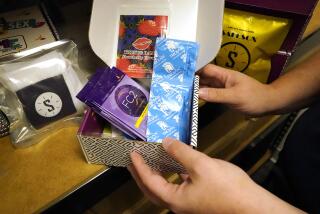Starting Kids on Right Path Pays Off in Long Run
- Share via
Which sex education programs most effectively motivate teenagers to avoid high-risk sexual behavior? The debate usually focuses on abstinence-only sex education versus comprehensive sex education. But a new study has found that one of the best inoculations against high-risk sexual activity among teens may well come from programs aimed at keeping kids off drugs, away from violence and in school. The study indicates that an anti-drug and anti-violence elementary school intervention program that promotes social competency, academic success and involvement in school has had the long-term effect of delaying the age at which sexual activity begins, and cutting rates of pregnancy and birth among young women and men.
That study, published Tuesday in the Archives of Pediatrics & Adolescent Medicine, looked at 350 Seattle students in 18 urban elementary schools, as well as their parents and teachers. The study began in 1981, when the children were in first grade, and continued until 1987, when they were in sixth. After five years, when no intervention was provided, the researchers revisited the same students. When those now-18-year-olds were compared with counterparts in the same socioeconomic groups who had had no early intervention, researchers saw significantly reduced levels of risky sexual behavior, including lower rates of sexually transmitted diseases and number of sexual partners. The effects of the program were evident up to age 21, when the study ended.
The pregnancy rate among the 21-year-old women in the multiethnic sample who took part in the intervention program was 38%, compared with 56% of women who were not in the program.
Similarly, the birth rate of those in the intervention group was 23% compared with 40% of those not in the program. The study also found that program participants delayed the age at which they became sexually active by about a year and were more likely to have used a condom the last time they had intercourse.
The intervention proved particularly effective among black students, who made up 26% of the participants. The rate of sexually transmitted diseases by age 21 among black students who took part in the program was 7%, compared with 34% for those who didn’t receive the intervention.
About 79% of the black students who had participated in the program reported using a condom the last time they had sexual intercourse, compared with 36% who were not in the program.
“The results fit with our theory that if children become bonded to school and committed to achieving in school in the elementary grades, they are less likely to risk that bond [later] by engaging in behavior that puts their future success at risk,” said researcher J. David Hawkins, director of the University of Washington’s Social Development Research Group and co-author of the Archives of Pediatrics & Adolescent Medicine study with Heather Lonczak, a research analyst at the University of Washington Social Development Research Group.
“We never predicted such a big drop in the teen pregnancy or birth rate in our sample,” Hawkins said.
Other intervention programs aimed at intensifying a child’s bond to home, school and community have shown similar outcomes to those of the Seattle-based program.
“This study is consistent with other research findings that have found a close connection between teens and their school, and teens and their parents was very powerful in helping kids take fewer sexual risks,” said Sarah Brown, director of the National Campaign to Prevent Teen Pregnancy, a nonprofit group in Washington, D.C., dedicated to reducing teen pregnancy. “The reason is, school and their personal relationships are more satisfying, so they don’t go looking for love in all the wrong places.”
Teachers in the Seattle-based intervention learned how to help children with impulse control, as well as teaching them how to get what they wanted without aggressive behavior and to recognize others’ feelings.
Parents were taught ways to support children’s academic success, manage family life and to give their children positive reinforcement. When children were in the fifth and sixth grades, parents took a series of classes called “Preparing for the Drug Free Years,” in which parents learned to monitor their children and help them practice refusal skills by role-playing. Children also learned refusal skills in the classroom.
Six years later, when the children who participated in the program turned 18, they were still “more bonded to school” than their counterparts in the control group, Hawkins said. The home- and school-focused program set children on a “better developmental trajectory,” so that through the teen years they had a positive, enduring stake in pro-social behavior and a belief that they would have success into adulthood.
“Kids are usually taught just to say ‘no’ and what not to do, but it is only the kids who are bonded to the social group that is promoting those standards who are likely to live accordingly,” said Hawkins. “So that if you have lost your bond to your family, you don’t care that mother tells you not to engage in risky behavior. If in elementary school the conditions are in place to help kids develop a strong attachment and commitment to education and their family, the bonding is the motivation to live according to their expectations.”
A hallmark of adolescent behavior is living by the norms of one’s peer group, said Dr. Gregory D. Zimet, a psychologist in the department of pediatrics at Indiana University School of Medicine. Zimet, who published a study last month in the journal Pediatrics, found that adolescent girls with high self-esteem were less likely to engage in early sexual activity, while boys with high self-esteem were more likely to report being sexually active. The results of the University of Seattle study, Zimet said, suggests that changing norms changes outcomes.
Part of the reason the intervention appears to have a long-reaching effect, said Lonczak, is because it offers hope. “It teaches children that they are competent, can succeed and go on to college and have a future,” said Lonczak. “This is not to say that sex education is not important. It is, and children need this kind of information.”
The power of intervention programs like the one in Seattle comes from working on the many-faceted environments that influence the behavior of teenagers.
“Simply giving young people information about something is not enough,” Brown said. “There has to be a reason, motivation and support for using it. What these programs do is change the conversation in their heads about what is in their self-interest, and provide a setting and a rationale for kids to do what is in their self-interest.”
*
Birds & Bees runs on Monday. E-mail Kathleen Kelleher at kathykelleher@adelphia.net.





